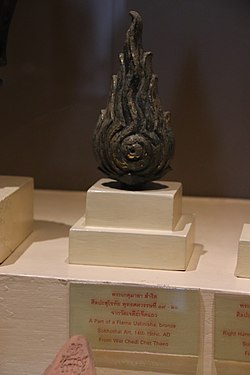Type a search term to find related articles by LIMS subject matter experts gathered from the most trusted and dynamic collaboration tools in the laboratory informatics industry.
| Translations of Ushnisha | |
|---|---|
| English | ushnisha |
| Sanskrit | उष्णीष (IAST: uṣṇīṣa) |
| Bengali | উষ্ণীষ (ushnish) |
| Chinese | 肉髻 (Pinyin: ròu jì) |
| Japanese | 肉髻 (Rōmaji: nikukei) |
| Korean | 육계 (RR: yukgye) |
| Glossary of Buddhism | |
| Part of a series on |
| Buddhism |
|---|
 |
The ushnisha (Sanskrit: उष्णीष, romanized: uṣṇīṣa) is a three-dimensional oval on top of the head. In Pali scriptures, it is the crown of Buddha, the symbol of his Enlightenment and Enthronement.

The Ushnisha is the thirty-second of the 32 major marks of the Buddha. The thirty-second of these is that the Buddha has a fleshy or cranial protuberance at the top of his head. Later sets elaborate that this is covered with hairs that curl in the direction of the sun.
Later on a second definition of Ushnisha was added, which was a flame that ascends from the middle of this protuberance.

The first representations of the Buddha in the 1st century CE in the art of Gandhara also represent him with a topknot, rather than just a cranial knob. It is thought that the interpretation of the ushnisha as a supernatural cranial protuberance happened at a later date, as the representation of the topknot became more symbolic and its original meaning was lost.[1]
Portrayal of Śākyamuni Buddha with an ushnisha has varied throughout history and depended on which school is doing the portrayal. The Sri Lankan Tamrashatiya school, which would later give rise to Theravada, portrayed him as bald and having an ushnisha extending into the sky and beyond the possibility of measurement.[2] The Gandharan school of Buddhism, however, never portrayed Śākyamuni with the protuberance on the skull, but with the long wavy hair drawn up on the top of the head in a cluster of curls or in a knot concealing the ushnisha.[3]
In Early Buddhism, the uṣṇīṣa was represented differently. The Mahāvastu (1.259f) and the Divyāvadāna, as well as the Theravadin Milindapañha, describe the marks of the cakravartin, an idealised world-ruler: uṣṇīṣa or patka turban, chhatra parasol, "horn jewel" or vajra, whisk and sandals. These were the marks of the kshatriya.[4]
The plastic art of early Mahayana Buddhism in Mathura presents bodhisattvas in a form called uṣṇīṣin "wearing a turban/hair binding", wielding the mudras for "nonviolent cakravartin rule".[4]
A bull figurine excavated from Lakhan-jo-Daro from Bronze Age Indus Valley Civilization has a similar Ushnisha styled knob above its head, its a unique feature and not applied to any other bull figurine indicating intelligence insignia.[5]